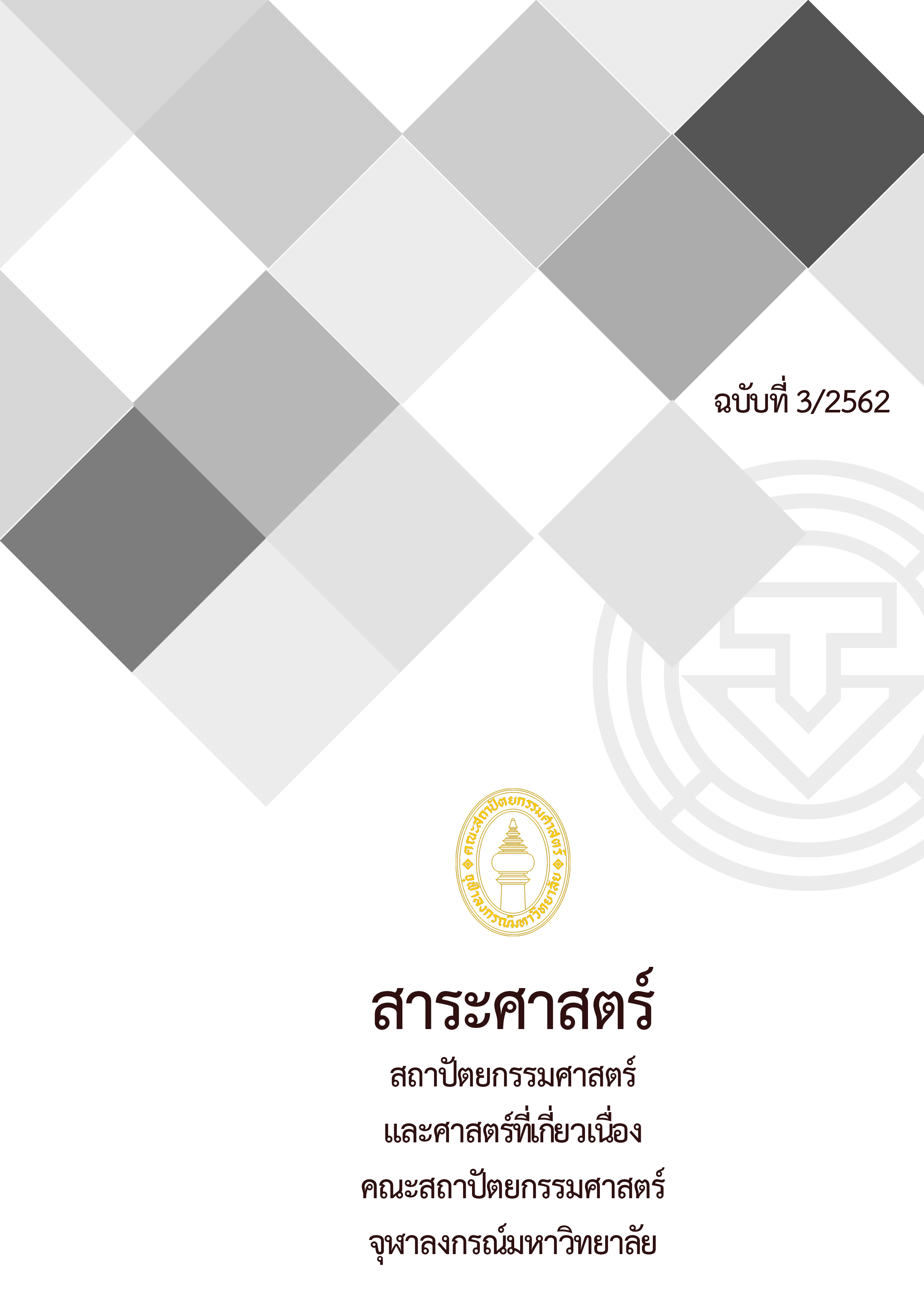Tenant Selection Concept for The Community Malls: Case Studies of The Sense Pinklao and Urban Square
Main Article Content
Abstract
Tenant selection appropriate to the target market is the one of the considerable for community mall’s development. This research aims to study the community mall development concept and tenant selection in the case studies of The Sense Pinklao (SP) and the Urban Square (US), which located in the inner city and urban fringe. The methods were site survey and in-depth interview with the developer. The data analysis was comparing similarity and disparity to both case studies.
The results are 1) Developers were priority considered to the location of the community with rather high density of population and located on main road. SP mall is in commercial and residential area in Pinklao, while US mall is in residential and university area in Prachachuen. 2) the most significant concept is make a choice for the users to be a center of stores and services with distinguished image and attractive among the other commercial. Eventually SP mall’s tenant selection concept is good quality and worthy for the target group and also meet the lifestyle. Meanwhile, US mall’s tenant selection concept is variety and convenient. 3) the most amount of tenant categories in SP mall are Health and Beauty (27.5 percent) followed by Food (25 percent). Even the most amount of tenant categories in US mall are Food (27.8 percent) followed by Health and Beauty (22.2 percent). Moreover, there are also have Supermarket, which is a major components. Furthermore, size of each stores are depends on the format of tenant and provided of the specification by the developer.
According to the research indicates that location is specifying the target group and the tenant. Also the most consequential tenant in nowadays are Food and Health and Beauty besides the Supermarket. This study contributes to the entrepreneur in the development of a community mall. Especially location and tenant are convenient access and fulfill the demand of target market’s daily life.
Article Details
References
กำพล อนันตพรพาณิชย์. “พัฒนาการคอมมูนิตี้ มอลล์ ในเขตกรุงเทพมหานคร และปริมณฑล.” วิทยานิพนธ์
ปริญญามหาบัณฑิต ภาควิชาสถาปัตยกรรมศาสตร์ คณะสถาปัตยกรรมศาสตร์และการผังเมือง มหาวิทยาลัยธรรมศาสตร์, 2553.
จุฑามาศ ศศิขัณฑ์. “ความสัมพันธ์ของผู้ใช้บริการกับร้านค้าภายในคอมมูนิตี้มอลล์ กรณีศึกษา อเวนิว รัชโยธินและนวมินทร์ ซิตี้
อเวนิว.” วิทยานิพนธ์ปริญญามหาบัณฑิต ภาควิชาเคหการ คณะสถาปัตยกรรมศาสตร์ จุฬาลงกรณ์ มหาวิทยาลัย, 2560.
บริษัท สยามฟิวเจอร์ ดีเวลลอปเมนท์ จำกัด (มหาชน). “รายงานประจำปี พ.ศ. 2555.” กรุงเทพฯ: บริษัท, 2556.
วิทิตยา ยิ้มเมือง. “ทำเลที่ตั้งโครงการและพฤติกรรมการใช้บริการศูนย์การค้าประเภทคอมมูนิตี้ มอลล์: กรณีศึกษา เจ อเวนิว ทองหล่อ ซอย 15 และ ลาวิลล่า พหลโยธิน.” วิทยานิพนธ์ปริญญามหาบัณฑิต ภาควิชาเคหการ คณะสถาปัตยกรรมศาสตร์ จุฬาลงกรณ์มหาวิทยาลัย, 2559.
ศิริพร บุญประสงค์. “ความสัมพันธ์ระหว่างสัดส่วนของร้านค้าหลักและร้านค้าทั่วไปที่มีผลต่อความสำเร็จของศูนย์การค้า
ชุมชน.” วิทยานิพนธ์ปริญญามหาบัณฑิต คณะสถาปัตยกรรมศาสตร์และการผังเมือง มหาวิทยาลัยธรรมศาสตร์, 2554.
ศิริวรรณ เสรีรัตน์, ปริญ ลักษิตานนท์และศุภร เสรีรัตน์. การบริหารตลาดยุคใหม่. กรุงเทพฯ: พัฒนาศึกษา, 2552.
สมจิตร ล้วนจำเริญ. การบริหารการค้าปลีก (PRODUCTION). กรุงเทพฯ: มหาวิทยาลัยรามคำแหง, 2541.
สมาคมอสังหาริมทรัพย์ไทย. “จัดผังคอมมูนิตี้มอลล์อย่างไรให้ประสบความสำเร็จ.” สืบค้น 19 มีนาคม 2560. http://thairealestate.org/content/detail/417/จัดผังคอมมูนิตี้มอลล์อย่างไรให้ประสบความสำเร็จ.
สาริยา ศรีเชื้อ. “แนวทางการวางแผนพัฒนาย่านการค้าในเขตชั้นกลางของกรุงเทพมหานคร: กรณีศึกษา เขตบางกะปิ.”
วิทยานิพนธ์ปริญญามหาบัณฑิต ภาควิชาการวางแผนภาคและเมือง จุฬาลงกรณ์มหาวิทยาลัย, 2540.
สุกฎ รัตนวรรณ. “ผลกระทบจากร้านค้าปลีกขนาดใหญ่ต่อผู้อยู่อาศัยโดยรอบ: กรณีศึกษาเขตบางซื่อ กรุงเทพมหานคร.”
วิทยานิพนธ์ปริญญามหาบัณฑิต คณะสถาปัตยกรรมศาสตร์และการผังเมือง มหาวิทยาลัยธรรมศาสตร์, 2552.
อรศศิพัชร์ ศิริวรรณพร. “ความพึงพอใจของผู้ใช้บริการในศูนย์การค้าชุมชน กรณีศึกษา: โครงการเดอะแจส รามอินทรา,
เดอะแจส วังหิน และแจส เออเบิร์น ศรีนครินทร์.” วิทยานิพนธ์ปริญญามหาบัณฑิต ภาควิชาเคหการ คณะสถาปัตยกรรมศาสตร์ จุฬาลงกรณ์มหาวิทยาลัย, 2560.
Alexander, A.A. and Muhlebach, R.F. “The Shopping Center: How Is It Different?” Journal of Property
Management 54,1 (1989): 58-60.
Brueckner, J.K. “Inter-store Externalities and Space Allocation in Shopping Centers.” Journal of Real
Estate Finance and Economics 7(1993): 5–16.
Carter, C.C. and W.J. Haloupek. “Dispersion of Stores of the Same Type in Shopping Malls: Theory
and Preliminary Evidence.” Journal of Property Research 19, 4 (2002): 291-311.
International Council of Shopping Centers (ICSC). “ICSC Shopping Center Definitions.” Accessed January
30, 2018. https://www.icsc.org/news-and-views/research/shopping-center-definitions.
Levy, Michael and Weitz, Barton A. Retailing Management. Boston: McGraw-Hill, 2007.
Yiu, Chung Yim and Xu, Yishuang. "A Tenant-mix Model for Shopping Malls." European Journal of
Marketing 46, 3 (2012): 524 – 541.


